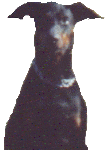A light-based
shunting semaphore (light-signal), which is
the most common used on PKP, consists of the pole
(painted white or gray) and the two-cell head, where
blue and white lights are placed vertically.
Shunting semaphores are signed as 'Tm' and the number
('Tm' means 'tarcza manewrowa' in Polish).
In some cases, the
shunting semaphore doesn't have a pole, but the head
is just placed on the small base with the name-plate.
Such semaphore is called 'dwarf-semaphore'.
Shunting signals can
be also reflected on a main semaphore, if such has a
while light cell (the lowest one). Such semaphore
should be signed by adding the small letter 'm' below
the name of the semaphore on the same plate below the
head.
If the shunting
semaphore is cancelled, a white cross is mounted
between the cells, on the head. Such semaphore must
be regarded as non-existed.
A shape-based
shunting semaphore (classic, mechanical)
consists of the pole and a square blue big plate on
that, and a set of two lights (valid during the
night). The position of the blue surface determines
the right or prohibition of making shunting that
cross this semaphore.
The cancellation of
the shape-based semaphore requires mounting the white
cross on the blue surface, or demounting the blue
square surface.



